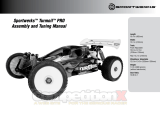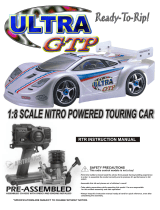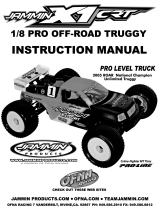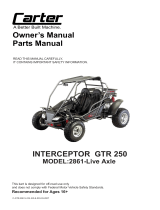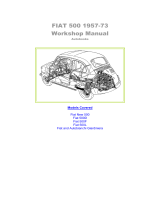
Red Bull Racing RB7: Step by Step
™
1
Stages 21-24
Pack 6
RB7
RADIO CONTROLLED • BUILD IT YOURSELF • NITRO ENGINE
™

Red Bull Racing RB7: Step by Step
™
2
RB7
Editorial and design by Continuo Creative, 39-41 North Road, London N7 9DP
All rights reserved © 2013 De Agostini UK Ltd, Battersea Studios 2, 82 Silverthorne Road, London SW8 3HE
RED BULL RACING RB7 complies with CE regulations.
NOT SUITABLE FOR CHILDREN UNDER THE AGE OF 14. THIS PRODUCT IS NOT A TOY AND IS
NOT DESIGNED OR INTENDED FOR USE IN PLAY. ITEMS MAY VARY FROM THOSE SHOWN.
Photo credits All photographs copyright
© DeAgostini
Visit our website www.model-space.com
Intro
Steering slider operation
Stage 21
The front shock mount
Stage 22
The left front push rod
Stage 23
The left front knuckle arm
Stage 24
The left front wheel bearings
Page 91
Page 95
Page 99
Page 103
Contents
Page 107

Red Bull Racing RB7: Step by Step
™
91
The RB7 model is tted with a sophisticated, precise
knuckle arm steering system that accurately mimics its
full-size counterpart. The steering mechanism of your
racing car is made up of three elements: the central
steering slider which controls the sideways movement;
the two pivoting knuckle arms on which the front wheels
are mounted; and the two adjustable track rods that link
the slider to the knuckle arms.
The steering slider is mounted on a slider base that
allows it to move to the left and the right. Two small
THE STEERING OF YOUR RB7 MODEL IS EXTREMELY PRECISE THANKS TO ITS
SOPHISTICATED KNUCKLE ARM LINKAGE. THIS MECHANISM ENABLES YOU TO
CORNER YOUR REMOTE-CONTROLLED MODEL TO THE LIMITS OF ROADHOLDING
OF THE CHASSIS AND TYRES.
STEERING SLIDER
OPERATION
Top view of the exposed steering mechanism of your RB7 racer, with the
front upper chassis and suspension removed. In the centre is the
steering crank (1), which will later be connected to the steering servo via
a steering rod. Turning the steering crank left and right moves the
steering slider (2) in the same direction. The slider is kept in line by the
steering slider base and is retained by two screws with washers (3). Later
on, the two track rods (shown below) will be attached to the two pillow
ball joints (4) at each end of the steering slider, conveying the sideways
movement of the steering slider to the two knuckle arms.
44
3 3
12
Knuckle arm
Track rod
Steering slider
The main components of the knuckle arm
steering linkage of your RB7 racer.
Knuckle arm
Track rod
Steering servo

Red Bull Racing RB7: Step by Step
™
92
This shows the right front suspension of your RB7 racer with the steering
fully turned to the left. The steering slider (1) and the track rod (2) have
pushed the crank of the steering knuckle (3) to the right and angled the
rear of the wheel to the outside.
screws tted with washers prevent it from jumping out of
the guide. The steering slider is connected to the longer
arm of the steering crank by a pin in the centre that
moves along the slot in the steering crank. This converts
the turning movement of the arm into a linear side-to-
side movement.
Each end of the steering slider is connected to a track
rod via a exible ball joint that allows it to move freely.
The track rods themselves have threaded sections used
to adjust their length and set the track of the wheels.
You will nd out more about adjusting the steering in a
later issue. Ball joints at the other ends of the track rods
provide a exible connection to the steering arms of the
two steering knuckles.
The knuckle arm converts the sideways movements of
the track rods back again into a turning movement. The
wheel shafts tted in the centre of the knuckle arm follow
the same movement, as do the wheels that are mounted
on the wheel shafts.
The geometry of your model’s steering linkage (left, below) is designed
to turn the wheels to precise angles, which is not possible with a crude
pivoting axle (left, top).
Top: With pivoting axle steering of the type used on the very earliest
cars, both wheels are mounted on one axle. A long steering shaft is
needed to give the leverage to make the axle turn, because doing so
means moving one wheel a long way forward and the other one back.
The front of the chassis also has to be narrow to give the axle and
wheels enough room to move.
Below: With knuckle arm steering, the axle is xed rigidly to the chassis
and only the knuckle arms at the ends are pivoted. The wheels are
mounted on the knuckle arms and as the wheels move through a much
smaller distance, short cranks pointing rearwards give enough leverage
to turn them. The wheels are able to move to much greater angles, and
as much less space is needed for the wheels to turn, the chassis can also
be wider.
Knuckle arm Chassis
Knuckle arm
Axle
Steering slider
Shaft
12
3

Red Bull Racing RB7: Step by Step
™
93
1
4
2
3
The left front wheel suspension of Sebastian Vettel’s Red Bull Racing
RB7. You can clearly see the upper and lower wishbones (1 and 2), with
the suspension pushrod (3) running diagonally upwards and the
steering track rod (4) connected to the upright. The steering geometry
of your model is a miniature replica of this arrangement.
PRINCIPLE OF THE KNUCKLE ARM
When you compare the knuckle arm steering system
of the model with the original car, there are hardly any
dierences, the main ones being the size and the steering
control mechanism. In a Formula 1 car, the driver moves
the track rods by turning the steering wheel, but in an
RC model car this function is taken over by the steering
servo and its linkages.
Compared to other steering mechanisms, the knuckle
arm steering system has a denite advantage: it enables
the two wheels to turn to the angle of the corner without
having to alter their position on the vehicle signicantly.
This has not always been the case. The steering of the
very rst motor cars was based on a simple pivoting
mechanism in which the two front wheels were attached
to each end of a single axle. The centre of the axle was
attached to a pivot, around which it could turn, and
originally was linked to a tiller like the one used to turn
the rudder on a boat.
Even after the tiller was replaced by a more ecient
steering wheel, this steering mechanism, which followed
the operating principle of four-wheeled horse-drawn
vehicles, was not really suitable for use in motor cars.
Moving the entire axle and wheels required considerable
eort on the part of the driver. In addition, the front of
the chassis in the area of the front axle had to be very
narrow so as to give the wheels and axle enough room to
swing and give the car a reasonably small turning circle.
The solution was provided by the knuckle arm steering
system in which the axle assembly remains xed in its
position on the chassis. The wheels are mounted on
knuckle arms which are turned to the left or right by the
steering box connected to the steering wheel, so moving
the wheels to the appropriate angles. Because the wheels
turn independently of the axle, less eort is required to
steer the vehicle. Also, modern mechanisms normally use
a servo-assisted steering-box, which further reduces the
eort of turning the steering wheel.
The principle of this steering system was developed
as early as 1816 by the German inventor Georg
Lankensberger, but it fell into oblivion until a new
steering mechanism was needed when the rst motor
car was invented. In 1891, Carl Benz, knowing nothing
of Georg Lankensberger’s invention, re-invented the
principle of the knuckle arm axle.
IMPROVED TRACKING STABILITY
Besides the advantages mentioned above, the axle
steering principle also improved the vehicle’s behaviour
when cornering. With the pivoting axle, the two wheels
remain parallel to each other when the steering wheel is
turned, but this is not ideal. When driving in a curve, the
radius described by the wheel on the inside of the curve

Red Bull Racing RB7: Step by Step
™
94
When driving in a straight line, the
two knuckle arms (1) at the outer
ends of the steering linkages are
parallel. When the steering slider (2)
moves to the right as shown below,
the track rods (3) also move to the
right, pushing and pulling the two
steering cranks (4) of the knuckle
arm.
As the knuckle arms change angle,
the oset of the steering slider from
the centre of the car means that the
two knuckle arms do not stay
parallel. The wheel on the inside of
the curve angles more towards the
centre of the curve (indicated by the
red line) than the wheel on the
outside of the curve (the green line).
1
4
1
33
2
4
to the centre is smaller than the wheel on the outside
of the curve. This cannot be the case with pivoting axle
steering because the wheels always remain parallel to
each other. The wheel which is closer to the centre of the
curve has to ‘scrub’ the road surface. The result is greater
tyre wear. Also, the vehicle becomes more dicult to
control because the wheel on the inside of the curve is
constantly pushing towards the outside of the curve.
Knuckle arms provide a way to solve this problem if
the ends of their cranks are angled slightly towards the
centre of the vehicle. The geometry can be organised so
that when the track rods are moved to the right or the
left, the knuckle arms move to dierent angles, turning
the wheel on the inside of the curve further than the one
on the outside.
ADJUSTABLE TOE-IN ANGLE
The angle to which the two wheels vary when turning
can be set very accurately by adjusting the length and
position of the track rods. In modern car manufacture,
designers and engineers take advantage of this exibility
to optimise the steering. In a racing car chassis, the
steering linkage is made as adjustable as possible so that
the car can be set up to suit dierent tracks and other
variable conditions.
The steering layout of your RB7 racer is also adjustable,
but is pre-congured so that each wheel drives on a
circular path following the ideal radius of the corner. With
a little experience, you will soon discover which setting
is best for your way of driving – an aggressive steering
setting or a ‘good-natured’ one.

Red Bull Racing RB7: Step by Step
™
95
Stage 21
HERE’S HOW YOU FIT THE FRONT SHOCK MOUNT ONTO THE FRONT CHASSIS OF
YOUR RB7 RACER.
THE FRONT SHOCK
MOUNT
Phillips screwdriver (size 2)
Tools & Materials
1 Front shock mount
2 Countersunk self-tapping
screw 3 x 20mm
3 2 countersunk self-tapping
screws 3 x 16mm
4 2 ball-headed screws 5.8mm
1
2
3
4

Red Bull Racing RB7: Step by Step
™
96
03
Tighten the screw fully, using the
size 2 Phillips screwdriver. 05
Tighten the screw fully, using the
size 2 Phillips screwdriver.
04
Insert the second 5.8mm ball-
headed screw into the hole of
the left arm (see red arrow). Tighten it as
much as you can with your ngertips.
01
In this session, you will attach the front shock mount to the front chassis. It is tted
behind the front pushrod mount. The front shock mount has a projection on its
underside that will help you place it in the correct position on the front chassis (see left
arrow, above). The two rear arms are xed in place by screws (see right arrow).
02
Place the front shock mount on
a at surface and insert one of
the two 5.8mm ball-headed screws into
the hole located in the right arm (see
red arrow). Tighten it as much as you can
with your ngertips.

Red Bull Racing RB7: Step by Step
™
97
08
Place the 3 x 20mm countersunk
screw into the front hole of the
shock mount. 09
Take your size 2 Phillips
screwdriver and turn the screw
fully into the hole. 10
Place one of the two 3 x 16mm
screws into the hole on the right
arm (see red arrow).
06
Before you continue, check
that you have both ball-headed
screws positioned accurately in their
holes, as shown above. If not, try
unscrewing them and then screwing
them back into the holes at a slightly
dierent angle.
07
Hold the shock mount as shown in the photo above, and place it on the front
chassis. The projection on the bottom of the mount ts into the large hole in the
centre of the front upper chassis, and the holes in the two arms of the shock mount should
t above those at the ends of the front upper chassis (see red arrows).

Red Bull Racing RB7: Step by Step
™
98
14
To check if you have tightened
both screws completely, look at
the assembly from the side. 15
If there is a gap between the shock mount and the upper chassis plate (see arrows
in Step 14), then you will need to repeat Steps 10-14 to correct the t. At the end of
this session, your front chassis should look like the one shown in the photo above.
11
Tighten the screw all the way into
the hole. 12
Place the second 2 x 16mm
countersunk screw into the hole
in the left arm (see red arrow). 13
Tighten the screw all the way into
the hole.

Red Bull Racing RB7: Step by Step
™
99
1
1
2
2
3
3
4
4
7
7
6
6
5
5
THIS IS HOW TO FIT THE LEFT FRONT PUSHROD, WHICH IS A KEY PART OF YOUR
RB7’S SUSPENSION.
THE LEFT FRONT
PUSHROD
Left front pushrod
3 x 12mm screw
Countersunk 3 x 10mm screw
Left front push rod crank
Pillow ball
5.8mm ball-headed screw
Left front pushrod crank collar
Phillips screwdriver (size 2)
Angled needle-nose pliers (smooth)
Tools & Materials
Stage 22

Red Bull Racing RB7: Step by Step
™
100
03
Insert the 3 x 10mm countersunk
screw into the 5.8mm pillow ball
(red arrow). 04
This is how the pillow ball and
screw should appear. 05
Take the assembly from Step
04, and screw it by hand, as far
as possible, into the upper hole of the
crank (see red arrow).
01
Insert the 5.8mm ball-headed screw into the hole on the left side of the crank (red
arrow), and screw it into place. 02
This is how the ball-headed
screw and crank should appear.

Red Bull Racing RB7: Step by Step
™
101
10
Place the 3 x 12mm screw through the hole in the crank assembly and into the hole
on the front chassis (red arrows).
09
Your assembly should now look
like the one shown above.
06
Continue to screw the assembly
into place with a screwdriver. 07
Place the collar as shown above,
then place the crank assembly
over it (red arrow). 08
Press the collar into the hole in
the crank.

Red Bull Racing RB7: Step by Step
™
102
14
Join the other end of the pushrod
onto the pillow ball of the crank,
tted in Step 02 (see red arrow). Press
the parts together until the ball locks
into the hole.
15
This is how the left front pushrod and wishbone assembly should look at this stage.
11
Turn the screw into the hole
until it stops, then loosen it by
about half a turn. 12
Position the left front pushrod
between the two left wishbones,
placing the hole at the outer end over
the pillow ball of the lower wishbone
(see red arrow).
13
Press the left front pushrod
onto the pillow ball of the lower
wishbone.

Red Bull Racing RB7: Step by Step
™
103
Phillips screwdriver (size 2)
Angled needle-nose pliers (smooth)
Tools & Materials
1 2
3
4 5 6 7
8
IN THIS STAGE, YOU FIT THE LEFT FRONT AXLE INTO THE KNUCKLE
ARM, AND THEN ATTACH THIS ASSEMBLY TO THE FRONT LEFT SUSPENSION
WISHBONES.
LEFT FRONT
KNUCKLE ARM
1 Left front knuckle arm
2 1.5mm Allen key
3 Left front axle
4 6mm locknut
5 5.8mm pillow ball
6 E-ring E2.5
7 3 x 3mm set screw
8 Kingpin
Stage 23

Red Bull Racing RB7: Step by Step
™
104
01
Position the left front knuckle
arm as shown, and place the
5.8mm pillow ball into the hole in the
projection on the right of the arm (red
arrow).
02
Screw the pillow ball all
the way into the hole with a size
2 Phillips screwdriver. 03
Hold the left front axle as shown,
and insert it into the hole in the
centre of the knuckle arm (red arrow).
04
Before pushing the axle fully
in, align the hole at its upper
end (see Step 03) with the holes of the
knuckle arm (see red line).
05
Push the axle all the way into the hole of the knuckle arm, until its end is ush with
the edge of the knuckle. Then, holding the knuckle arm as shown, look through the
hole on the outside (left arrow) to check that the holes are aligned correctly, as in Step 04.
If not, turn the axle until they align correctly. Then, using the 1.5mm Allen key, insert the 3
x 3mm set screw into the hole at the end of the axle (right arrow), but don’t screw it all the
way in.

Red Bull Racing RB7: Step by Step
™
105
06
Position the front chassis
assembly so that you can see
both pillow balls of the left wishbones,
as shown, and align the balls vertically.
07
Place the knuckle arm as shown in the photo, and position the ends of the
wishbones above and below the axle. Make sure that the holes of the pillow balls
remain aligned as vertically as possible.
08
Look at the assembly from above
through the hole marked with a
red circle. If you can see through it, the
balls are aligned correctly. If not, remove
the wishbones and repeat Steps 06 and
07.
09
Insert the kingpin into the hole
at the top of the knuckle arm
(red arrow). Push it into the hole until the
groove highlighted in Step 10 is visible.
10
Turn over the assembly, and
locate the groove at the bottom
of the kingpin (red arrow). Use pliers to
clip the E-ring into this groove.

Red Bull Racing RB7: Step by Step
™
106
11
Take the 1.5mm Allen key and tighten the 3 x 3mm set screw to secure it in place, as
shown in Step 12. 12
The photo above shows how far
the 3 x 3mm screw should be
screwed into the hole.
13
Turn the 6mm locknut, as shown
above, onto the threaded end of
the axle. 14
At the end of this stage, the left front knuckle arm has been connected to the two
wishbones. You are one step closer to completing the left side of the front chassis.

Red Bull Racing RB7: Step by Step
™
107
THE WHEEL BEARINGS ENSURE THAT THE WHEELS OF YOUR MODEL RB7 ARE
FREE TO ROTATE WITH A MINIMUM OF FRICTION. HERE’S HOW YOU INSTALL THE
BEARINGS OF THE LEFT FRONT WHEEL.
THE LEFT FRONT
WHEEL BEARINGS
Cross wrench
Tools & Materials
1 Left front wheel bearings x 2
1
Stage 24

Red Bull Racing RB7: Step by Step
™
108
01
To install the two wheel bearings, you will need the left front wheel that you
assembled in Stage 7, the bearing insertion tool from Stage 18, and the cross
wrench from Stage 4. 02
Take the cross wrench and insert
the adapter into the arm labelled
‘10’.
03
Place one of the wheel bearings
onto the end of the adapter.
Then push the bearing into the hole in
the centre of the wheel (red arrow) and
remove the cross wrench and adapter.
04
Now turn the wheel around and
repeat Step 03, inserting the
second bearing into the other side of the
centre of the wheel (red arrow).
05
At the end of this stage of
assembly you have completed
the front left wheel.
/
